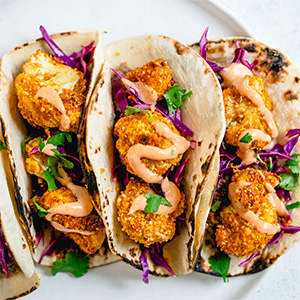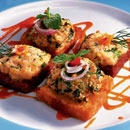ENVIRONMENTAL NUTRITION: Good nutrition in whole grain bulgur
Indigenous to the Mediterranean region, bulgur has been an integral part of Middle Eastern cuisine for thousands of years. Biblical references, in which it is referred to as arisah, meaning "first of the coarse meal," indicate it was prepared by the Babylonians, Hittites and Hebrews 4,000 years ago, and by the Romans, Arabs and Egyptians as early as 1,000 B.C. This staple was declared one of five sacred crops, along with rice, millet, barley and soybeans, by the Chinese Emperor in 2,800 B.C.
Bulgur (Triticum spp.) is cracked wheat that has been parboiled, dried and broken into granules of varying sizes. Some small Middle Eastern villages still retain the ancient preparation of boiling large pots of wheat for days, spreading it on rooftops to sun dry, and then cracking the kernels into coarse pieces before sieving them into different sizes for various uses. Though most often made from durum wheat, any wheat can be made into bulgur. Bulgur, a whole grain, has all the associated benefits, such as healthy weight and gastrointestinal health, due to its rich nutrient profile. A one-cup serving provides 33 percent Daily Value of dietary fiber, along with 15 percent DV of magnesium and 55 percent DV of manganese, two important minerals for healthy bones. In addition, bulgur contains a host of health-protective phytochemicals concentrated in the bran and germ, which include lignans, phytosterols, phenolic acids and flavonoids.
Current scientific evidence, reported in the May 2011 Journal of Nutrition, indicates that whole grains are important in lowering the risk of chronic diseases, such as coronary heart disease, diabetes and cancer. A study published in the August 2007 journal PLoS Medicine is one of several studies supporting increased whole grain consumption for the prevention of type 2 diabetes, and bulgur, specifically, has been found to produce a low glycemic response among people with diabetes. More recent evidence, published in the May 2011 British Journal of Nutrition and the November 2010 American Journal of Clinical Nutrition, showed that a diet which includes more whole grains offers health benefits by improving biomarkers of cardiovascular disease.
Available prepackaged and in bulk bins, bulgur stores well for about six months in a tightly sealed, refrigerated container, such as a glass jar (to prevent rancidity.) Many different grinds of this nutty tasting grain are available, from coarse to fine. Coarse grinds take longest to cook, making them suited to stuffings, pilafs, artisan breads and casseroles. Medium and finer grinds work well in cereals, side dishes, and salads, including tabouleh, its best known use. Bulgur cooks quickly and is as versatile as rice, interchangeable in most recipes.
Notable Nutrients
1 cup bulgur, cooked
Calories: 151
Dietary Fiber: 8 g (33 percent DV)
Protein: 6 g (11 percent DV)
Iron: 1.7 mg (10 percent DV)
Magnesium: 58 mg (15 percent DV)
Manganese: 1 mg (55 percent DV)
(DV = Daily value)
ASIAN TABOULEH SALAD
Recipe adapted courtesy Whole Grains Council and Sunnyland Mills
Makes 4 servings.
1/2 cup bulgur
1 cup water
1 (1 pound) bag frozen Asian vegetables
Dressing:
1/2 teaspoon honey
1 tablespoon olive oil
1 teaspoon soy sauce
1 tablespoon lemon juice
2 teaspoons dried cilantro
1 teaspoon ground ginger
Fresh ground pepper, optional
In a saucepan, boil bulgur in water. Cover and set aside for 25 minutes until liquid is absorbed.
Defrost frozen vegetables in a microwave safe dish.
In a large bowl, whisk all remaining dressing ingredients together. Stir in vegetables and bulgur.
Nutritional Information per Serving: 129 calories, 4 grams (g) fat, 20 g carbohydrates, 3 g protein, 4 g fiber, 52 milligrams sodium.
(Environmental Nutrition is the award-winning independent newsletter written by nutrition experts dedicated to providing readers up-to-date, accurate information about health and nutrition in clear, concise English. For more information, visit www.environmentalnutrition.com.)











Comments